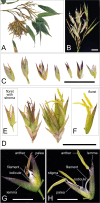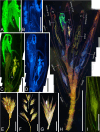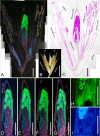Henon bamboo flowering recorded first time in 120 years revealed how Aciculosporium take affects the floral organs of the host
- PMID: 39720017
- PMCID: PMC11666424
- DOI: 10.47371/mycosci.2024.06.001
Henon bamboo flowering recorded first time in 120 years revealed how Aciculosporium take affects the floral organs of the host
Abstract
Flowering of Henon bamboo (Phyllostachys nigra var. henonis) was observed in Japan in 2020s. We estimated that the observation of flowering was recorded for the first time in 120 y. Additionally, stromata of Aciculosporium take have also been observed in the flower buds, or spikelets, of Henon bamboo. Aciculosporium take usually forms stromata at the vegetative shoot apex, which presumably originated from ancestral pathogens affecting floral tissues. However, given the infrequent occurrence of bamboo flowering events, it is unclear whether A. take still retains the ability to colonize ovaries of flowers. To ascertain the location where the fungus forms stromata, anatomical and histological analyses were performed. Because flower buds, including floral organs, are fragile, tissue sections were prepared by adhering them to cellophane tape, and subsequently examined using a triple fluorescent staining method. The findings showed that the fungus did not invade the ovaries but formed stromata from the apical rudimentary floret within the flower buds.
Keywords: Clavicipitaceae; endophytic fungi; mass flowering; ovary; witches' broom.
2024, by The Mycological Society of Japan.
Figures





Similar articles
-
Mechanisms of bamboo witches' broom symptom development caused by endophytic/epiphytic fungi.Plant Signal Behav. 2010 Apr;5(4):415-8. doi: 10.4161/psb.5.4.10834. Epub 2010 Apr 2. Plant Signal Behav. 2010. PMID: 20118669 Free PMC article.
-
Specific in situ visualization of the pathogenic endophytic fungus Aciculosporium take, the cause of witches' broom in bamboo.Appl Environ Microbiol. 2009 Jul;75(14):4829-34. doi: 10.1128/AEM.00635-09. Epub 2009 May 22. Appl Environ Microbiol. 2009. PMID: 19465522 Free PMC article.
-
Does monocarpic Phyllostachys nigra var. henonis regenerate after flowering in Japan? Insights from 3 years of observation after flowering.PLoS One. 2023 Jun 12;18(6):e0287114. doi: 10.1371/journal.pone.0287114. eCollection 2023. PLoS One. 2023. PMID: 37307263 Free PMC article.
-
Flowering of Woody Bamboo in Tissue Culture Systems.Front Plant Sci. 2017 Sep 14;8:1589. doi: 10.3389/fpls.2017.01589. eCollection 2017. Front Plant Sci. 2017. PMID: 28959269 Free PMC article. Review.
-
Mechanisms and function of flower and inflorescence reversion.J Exp Bot. 2005 Oct;56(420):2587-99. doi: 10.1093/jxb/eri254. Epub 2005 Aug 30. J Exp Bot. 2005. PMID: 16131510 Review.
References
-
- Bonga, J. M.(1961). A method for sectioning plant material using cellulose tape. Canadian Journal of Botany, 39, 729-730.
-
- Kawamoto, T.(2003). Use of a new adhesive film for the preparation of multi-purpose fresh-frozen sections from hard tissues, whole-animals, insects and plants. Archives of Histology and Cytology, 66, 123-143. https://dx.doi.org/10.1679/aohc.66.123 - PubMed
-
- Kawamura, S.(1911). On the cause of the flowering of Bamboo. The Botanical Magazine, Tokyo, 25, 237-269 (in Japanese).
-
- Kobayashi, K., Umemura, M., Kitayama, K., & Onoda, Y.(2022). Massive investments in flowers were in vain: mass flowering after a century did not bear fruit in the bamboo Phyllostachys nigra var. henonis. Plant Species Biology, 37, 78-90.
-
- Maeda, Y., Kobayashi, M., Ichisawa, A., Kawai, T., Tsuchiya, R., Yabe, H., & Koyama, K. (2023). Observational records of black bamboo that bloomed simultaneously at Kawahara-cho, Tottori City in 2021. Tree and Forest Health, 113-114.
LinkOut - more resources
Full Text Sources
Miscellaneous
